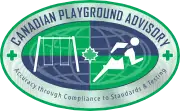EVERPLAY - NO Equal
Playground Protective Surfacing is a complex system that can become a major financial disaster for Owner/Operators, and their Consultants. Generally, surfacing is an afterthought or necessary evil to the main event the Play Structure. Failure to consider the Functional Longevity and Sustainability of the surfacing selection is a problem. EVERPLAY has been installed for more than 35 years and provides any project with injury prevention, functional longevity, and sustainability. If the longer view (10 years or more) is taken and maintenance costs are considered. EVERPLAY arguably is lower cost than Engineered Wood Fiber (EWF) and provides similar injury prevention to 200mm (8”) of EWF.
EVERPLAY has a history of long term compliance, functional longevity. and no repairs, other than vandalism, which is in sharp contrast to tiles and other PIP systems that have a marginal product and reasonable service system during the warranty period. Better to have no need for repairs with EVERPLAY than hope for the continued indulgence of poor quality suppliers.
The problem that most Owner/Operators and their Consultants face is the determination of the Equal and visual comparisons are misleading and are likely to cost the Owner/Operator significantly in the future.
This paper presents first the technical aspects of Poured-In-Place surface systems that an Owner/Operator must know. The second part is a more detailed explanation with links to relevant articles and knowledge sources that will expand on Standards, and emerging trends that affect asset management, minimizing liability and risk assessment. This is followed by white papers on injury prevention. The white papers are complimented with LA/CES approved courses that will enhance the understanding of diverse issues related to playgrounds. Next there is test data, including test data for the EVERPLAY third party laboratory testing long with testing of the same surface at the time of installation and as they stand in 2021. Lastly, we provide you with a Generic Protective Surfacing Specification including a list of standards and test submissions. At any time during this journey, you are invited to contact EVERPLAY to discuss your specific needs.
We also provide a CHECK LIST for measuring the equivalence of any surface systems to EVERPLAY
There are critical elements to the design and installation of the Poured-In-Place surfacing, including:
Chemistry, The adhesive forms the bond between the rubber granules.
- The adhesive must remain strong – not allowing bonds to break for 15-25 year.
- The adhesive must resist degradation through exposure to UV light causing loss of flexibility.
- EVERPLAY utilizes a unique polyurethane binder that is UV stable and has been the same formulation since 1985.
- The adhesive is moisture cured and must be insensitive to moisture changes during installation, causing “foaming” and a loss is integrity of the bond.
- The adhesive must cure through a range of humidity without draining down, resulting in loose granules and a failed surface.
- The adhesive must cure through a range of temperatures 0o to 40oC (32o to 105oFwithout draining down, resulting in loose granules and failed surface.
EVERPLAY - No Equal Check List
The following is a check list of features related to performance of a Protective Surface as defined in CSA Z614, Clause 10.1.
10 Surfacing
10.1 Energy absorbency of a surface material
The surfacing absorbency in the protective surface zone shall have a gmax not exceeding 200 and a HIC not exceeding 1000 when tested for the defined fall height. the test methos specified in ASTM F1292 or CEN EN 1177:1997 shall be used for testing protective surfacing.
The level of injury prevention at the limits of the CSA Z614 is stated in the introduction of the EN1177 Standard.
“Limiting the HIC value to a maximum of 1000 is equivalent to a 3% chance of a critical head injury (MAIS 5), an 18% probability of a severe (MAIS 4) head injury, a 55% probability of a serious (MAIS 3) head injury, a 89% probability of a moderate head injury (MAIS 2), and a 99.5% change of a minor head injury (MAIS 2), the average male adult.”
The value of 200g is a 10% risk of skull fracture
EVERPLAY brings the Owner/Operator the confidence their protective surfacing system will not only reduce the frequency and severity of injury over other PIP systems, but in all likelihood will have a lower overall Life-Cycle cost of almost all maintained protective surfaces, including EWF.
For further readings and explanations read;
Huber, Rolf and Kutska, Kenneth, Protecting Children from Surface Impact Injuries, What does Critical Height mean? - Is Specified Height (ASTM F3351) the answer?
Huber, Rolf, Impact Attenuation Values and Prevention of Head Injuries in Children’s Playgrounds Do Children Deserve the Same or Better Protection than in an Automobile Crash
Kutska, Kenneth, Playground Safety Is No Accident – 6th Edition, Developing a Public Playground Management and Operation Program
Courses at standards compliance.thinkific.com
Playground Surfacing Technician – Putting Theory to Practice
Professional Considerations in Design of Public Playspaces
Landscape Architect CEU credit course Ground Level Accessible Routes
Determination of Fall Height – Compliance with Standards, Liability Issues
Welcome to EVERPLAY





